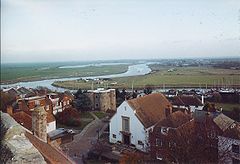Rye, Sussex
| Rye | |
|---|---|
 The Ypres tower, Rother, Rye Harbour and marshes seen from the tower of St Mary's church, Rye. |
|
| Rye shown within East Sussex | |
| Area | 4.2 km2 (1.6 sq mi) |
| Population | 9,041 (Parish-2012) |
| • Density | 2,810/sq mi (1,080/km2) |
| OS grid reference | TQ920206 |
| • London | 53 miles (85 km) NW |
| District | |
| Shire county | |
| Region | |
| Country | England |
| Sovereign state | United Kingdom |
| Post town | RYE |
| Postcode district | TN31 |
| Dialling code | 01797 |
| Police | Sussex |
| Fire | East Sussex |
| Ambulance | South East Coast |
| EU Parliament | South East England |
| UK Parliament | |
| Website | Town Council |
Rye is a small town in the non-metropolitan county of East Sussex, within the historic County of Sussex, England, which stands approximately two miles from the open sea and is at the confluence of three rivers: the Rother, the Tillingham and the Brede. In medieval times, however, as an important member of the Cinque Ports confederation, it was at the head of an embayment of the English Channel and almost entirely surrounded by the sea.
Rye is officially a civil parish but with its historic roots has the status of a town; at the 2011 census it had a population of 4773. During its history its association with the sea has included providing ships for the service of the King in time of war, and being involved with smuggling gangs of the 18th and 19th centuries such as the notorious Hawkhurst Gang who used its inns such as The Mermaid Inn and The Olde Bell Inn, connected by secret passageway.
Those historic roots and its charm make it a tourist destination, and much of its economy is based on that: there are a number of hotels, guest houses, B&Bs, tea rooms and restaurants, as well as other attractions, catering for the visitor. There is a small fishing fleet, and Rye Harbour has facilities for yachts and other vessels.
The name of Rye is believed to come from rie meaning a bank. Medieval maps show that Rye was originally located on a huge embayment of the English Channel called the Rye Camber, which provided a safe anchorage and harbour. Probably as early as Roman times, Rye was important as a place of shipment and storage of iron from the Wealden Iron Industry. The Mermaid Inn originally dates to 1156.
Rye, as part of the Saxon Manor of Rameslie, was given to the Benedictine Abbey of Fécamp in Normandy by King Æthelred; it was to remain in Norman hands until 1247.
...
Wikipedia

